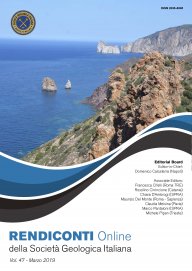
Groundwater temperature as a natural tracer to characterize hydraulic behaviour and geometry of carbonate aquifers: Mt. Nerone karst system, central Italy
Andrea Tamburini (a) & Marco Menichetti (a)
(a) Department of Pure and Applied Sciences (DiSPeA), University of Urbino, Via Cà le Suore 2/4-61029, Urbino, Italy.
Corresponding author e-mail: andrea.tamburini@uniurb.it
DOI: https://doi.org/10.3301/ROL.2019.22
Volume: 47/2019
Pages: 121-125
Abstract
Temperature variations in groundwater discharge from the Giordano karst system (northern Apennines) have been observed continuously for six months (from January 2016 to July 2016), to determine the flow patterns and geometrical properties of aquifer. The karst system discharge about 32.2 L/s on average during over the hydrological year and it’s characterized by two outlets: a basalcontinuous
spring (BCS) with a mean discharge of 8.9 L/s and an upper-intermittent spring (UIS) with a mean discharge of 23.3 L/s, located about 60 m above the previous one.
Results show significant difference in the two spring outlets between the time lags as well as non-simultaneous and not analogue responses of temperature (T) to the same recharge events: temperature of UIS range from 9.7 to 10.7°C whereas temperature of BCS remain rather stable, ranging from 9.8 to 9.9°C. This data suggests a stratification of the water along the aquifer probably associated by different residence times and linked to the structural organization of karst aquifer (conduit and fracture networks): deeper and oldest water in the BCS and youngest water in the UIS.
Keywords
Get Full Text